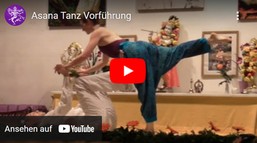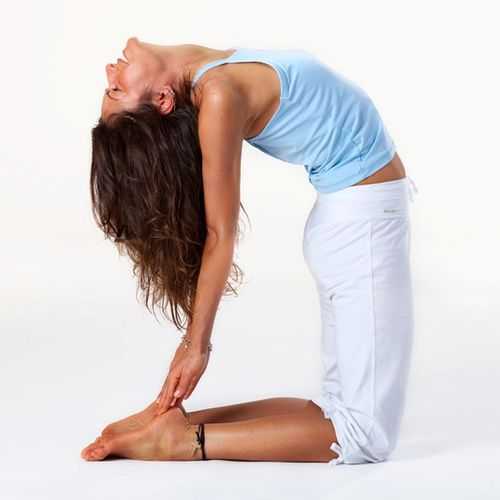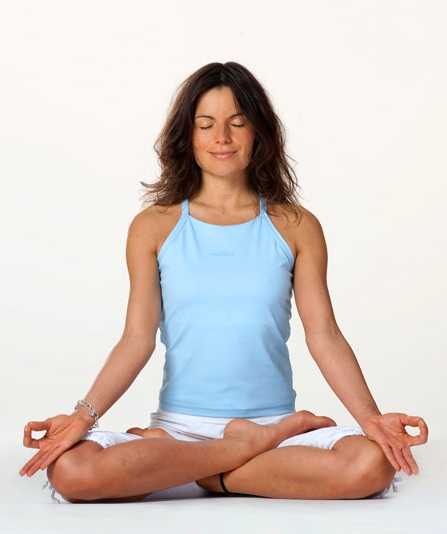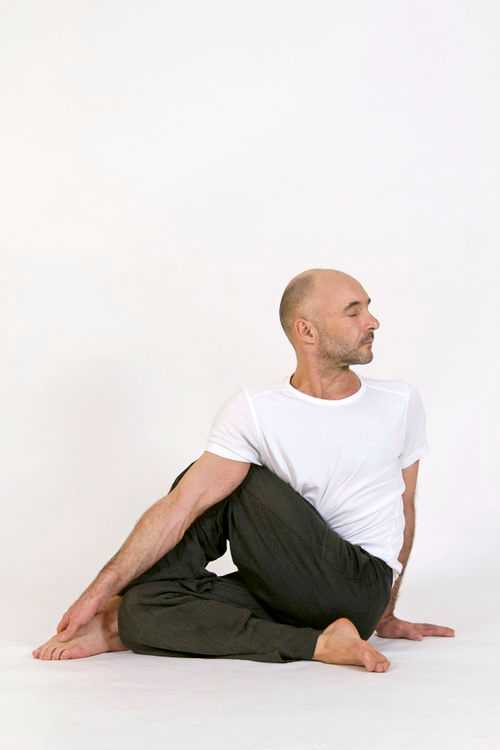

Asana
An Asana or body position, seat is a main component of hatha yoga. «Asana» comes from the root «as» and means «to sit». Originally it referred to the surface on which the yogi sits: it should be clean, in a quiet environment, not too high or too low. The meaning «yoga posture» is the best known. The asanas are said to be «firm and pleasantly light», according to the Sutras of Patanjali. However, it does not mention different postures. From later commentaries on the Yoga Sutras, it becomes clear that «Asana» refers to Padmasana, the Lotus Position.
If you look at the pictures of Asanas, it is easy to believe that an asana is something static. It is then easy to overlook the fact that Asana is constant movement (in rest). It is said that Pranayama can unleash strong powers and that the body must be prepared for them. «Asanas» purify and strengthen the body for Pranayama. When performed with mindfulness, Asanas can themselves become a form of meditation. This is especially true if you practice long and quiet.
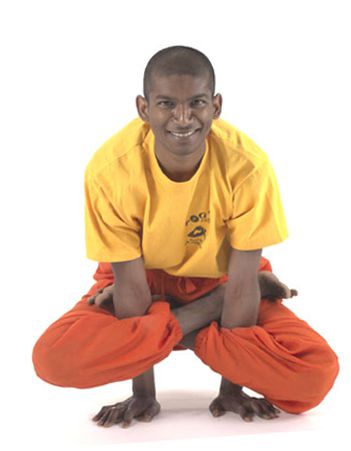 Yogi Karma Ratna in Kukkutasana
Yogi Karma Ratna in Kukkutasana
These are a kind of gesture and have certain effects. So they can affect the structure of the body, the mind, the nerves, organs and senses. These can influence and change the body on an energetic level.
According to the scriptures, there are as many Asanas or body positions as there are living things in this universe. In total, there are 8,400,000 Asanas, matching the Lakhs of bodies. The Asanas correspond to the different postures that can be found in the different life forms in the creation.
Of the 84 Lakhs of Asanas, 84 are considered the best; and of these, 32 were found to be useful to man. Asanas can be divided into two groups, namely the meditation positions and the positions for health and strength. After the Yoga-Shastras there are four outstanding meditation positions: Padmasana, Siddhasana, Swastikasana and Sukhasana.
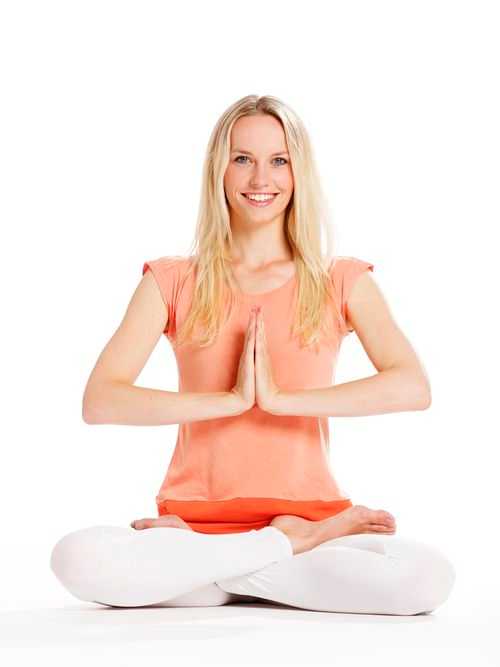 A Yogini in Padmasana, the Lotus Seat
A Yogini in Padmasana, the Lotus Seat
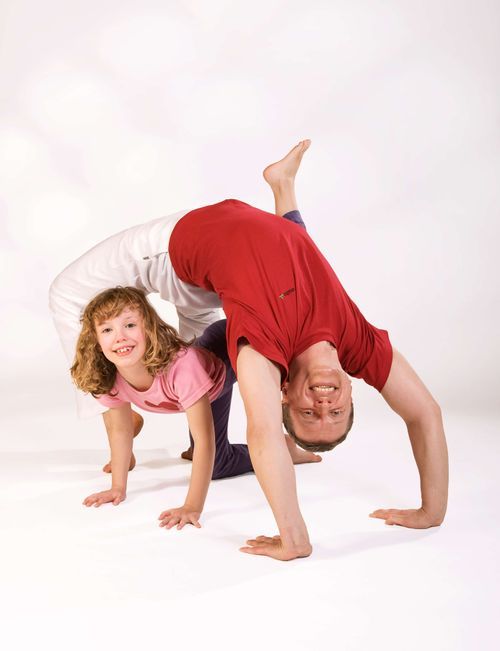 Parents can practice Yoga together with their children
Parents can practice Yoga together with their children
Contents
➳1 Healing Effect of Yoga Exercises
➳2 Yoga Asanas and Physical Exercises
➳3 The Meditation Positions
➳4 Sukadev on the Asana
➳5 Swami Saradananda on the Asana
➳6 A few General Guidelines for Asana Practice
➳7 Positions to Exercise the Body
➳8 Who can do Asanas?
➳9 Videos about Asanas
➳9.1 Yoga for Beginners
➳9.2 Yoga Class Intermediate — Yoga Vidya Basic Series
➳9.3 Asanas, the Body Postures — Teaching with Sukadev
➳9.4 Asana Asana Dance Performance
Healing Effect of Yoga Exercises
Asanas keep the muscles supple and spine elastic, improves mental capacity and develops lung capacity, strengthen the internal organs and provide longevity. The practice of yoga Asanas enriches the blood with high levels of oxygen and stops the accumulation of venous blood. The body is filled with a great deal of energy. The brain centers and the spinal cord are strengthened and invigorated. The memory is improved and the mind sharpened. Intuition is developed.
The practice of Asanas strengthens the balance in the body and also guarantees mental balance. Yoga exercises contribute to the relaxation of the body, so that nervous tension can be resolved. Practicing Asanas eliminates diseases and makes the body light, firm and stable. Each Asana can help with a certain physical ailment.
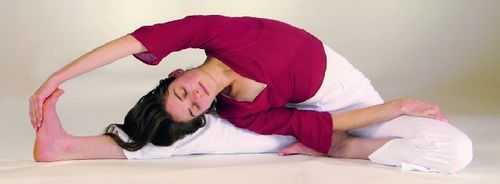 Yogini in turned forward bend of a variation of Paschimotthanasana
Yogini in turned forward bend of a variation of Paschimotthanasana
➳Shirshasana Shirshasana is useful for a dull brain. It develops the mind and the memory. This contributes to the storage of Ojas Shakti in the brain. This helps in the preservation of Brahmacharya, heals many diseases. This improves vision and hearing by adding blood to the brain.
➳Sarvangasana develops the thyroid gland, strengthens the lungs and heart, and makes the spine elastic.
➳Shirshasana and Sarvangasana increase vitality and prevent aging. They make the spine elastic. They renew and rejuvenate the entire system. The thyroid glands are stimulated and re-energized.
➳Matsyasana is good for the development of the lungs, the brain and the eyes. The Asana also strengthens the upper part of the spine.
➳Paschimotthanasana and Mayurasana strengthen the digestive fire and improve digestion. Paschimottanasana reduces fat in the belly.
➳Bhujangasana, Shalabhasana and Dhanurasana improve intestinal peristalsis, help prevent constipation and cure abdominal disorders. Roll in the Dhanurasana gives a very good belly massage.
➳Agni-Sara-Kriya, Uddiyana-Bandha and Mayurasana are also digestive and appetite-promoting.Ardha-Matsyendrasana is good for liver and bile.
➳Tadasana, Trikonasana and Garudasana make us bigger.
➳Shavasana relaxes the body and the mind and gives complete balance and peace.
You do not practice Asanas and Pranayama to get strong muscles. Muscles do not mean health. The healthy and harmonious functioning of the endocrine glands, the internal organs, the nervous system and the mind — that is what one needs and what the regular practice of yoga Asanas and Pranayama does.
Yoga Asanas and Physical Exercises
Normal body exercises develop only the superficial muscles of the body. On the other hand, Asanas are intended for the thorough exercise of the internal organs: liver, spleen, pancreas, intestine, heart, lungs, brain, and the major endocrine glands of the body. Asanas harmonize the internal organs and invigorate the thyroid gland and other endocrine glands, which play a very important role in maintaining good health.
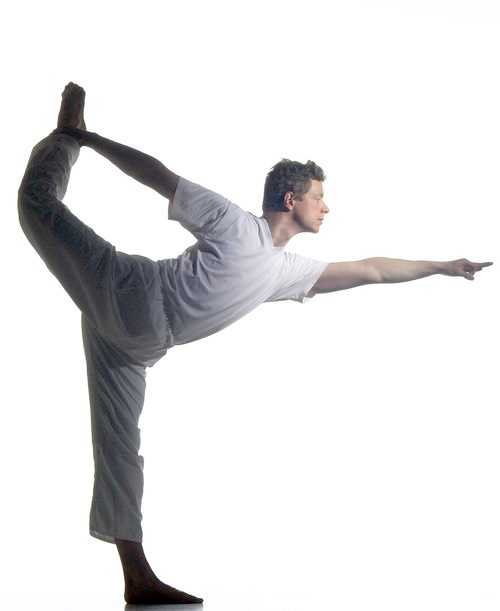 A Yogi Natarajasana, the dancer
A Yogi Natarajasana, the dancer
Physical exercises drive the Prana outwards. Asanas send the Prana inside and spread it evenly throughout the body and its various systems. Asanas are not just physical exercises. These are more than that. These give mental balance. These help in mastering the emotions. These bring spiritual benefits.
Asanas awaken the serpent power or Kundalini, sleeping in the Muladhara Chakra. This gives the aspirant bliss, power and Yoga-Samadhi. If you perform fifty chin-ups or run a marathon every day for five years, it will not contribute in any way to the awakening of this mysterious force of the Kundalini.
Practicing Asanas does not cost you anything. You do not need dumbbells, weights or bars to set up the yoga room. You only need a simple soft blanket to practice the Asanas on.
The Meditation Positions
The Meditation Positions are particularly suitable for Japa and contemplation. These release the mind from the grief and worries of everyday life. These calm the nerves, relax the body, strengthen the spirit and give balance. The meditation positions increase the digestive fire and give a good appetite, health and happiness. These eliminate rheumatism. These keep gases, bile and mucus in balance. These cleanse and strengthen the nerves in the legs. These are capable of sustaining the Brahmacharya.
«Sthira Sukham Asanam» — «An Asana is firm and enjoyable», says Patanjali in his Yoga Sutras. This must not cause pain or discomfort. A solid Asana concentrates the mind. The body is at best like a rock; without shaking. You could become a living statue as you sit down to the Dhyana. When the seat becomes firm, the meditation goes deeper, and then you no longer have body awareness.
When you sit in the position, you think, «I am as firm as a rock. Nothing can shake me.» Suggest it to your mind a dozen times. Then the Asana will continue to evolve. You could last in one of the four positions for three hours without interruption; on the way to the Asana-Jaya, to mastering the Asana. If you manage to hold a position for an hour, you will gain the one-pointedness of the mind, experiencing infinite peace and Ananta inside.
Start with half an hour and gradually increase the duration. If, after some time, you feel severe pain in your legs, loosen your legs, massage them for five minutes and then sit back in the Asana. If you have developed further, you will become pain free, and then you will experience joy. Practice the Asana in the morning and in the evening.
Stay with an Asana, either Padma, Siddha, Swastika or Sukha. Make them steady and perfect by repetitive practice. Stick to an Asana instead of changing it. Experience the full benefits of a single Asana for meditation. If you practice regularly for a year, you may be able to sit uninterruptedly for three hours.
Sukadev on Asana
Record of a teaching video about Asana by Sukadev.
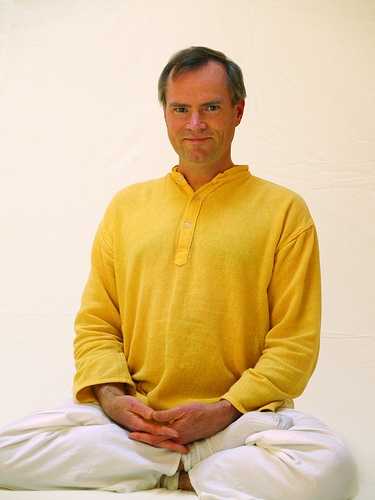 Sukadev Bretz, founder of Yoga Vidya, disciple of Swami Vishnudevananda
Sukadev Bretz, founder of Yoga Vidya, disciple of Swami Vishnudevananda
Asana is one of the best known Sanskrit words. Asana means first of all the way to sit down. Asana means seat. Assuming you have a pillow, then the pillow would be called Asana. Assuming you have a chair, it is an Asana too. It is sometimes said in India, «Have you prepared your Asana?» That is, the seat where you sit on it. The Asana is also your own sitting posture. If you sit down, it's a sitting posture, that's an Asana. And in another sense, the Asana is also the inner attitude, an inner attitude that you have to live, an inner attitude that you have to other people. And of course, the Asanas are also the different body postures, which you in particular also keep quiet.
From the classical point of view there are initially four main postures, which are also called Asanas:
➳Padmasana — the Lotus
➳Siddhasana — the Position of the Perfect
➳Muktasana — the Liberated Position
➳Sukhasana — Simple, Pleasant Position
Of course, there are also the Hatha Yoga Asanas to the sitting postures. And there is a lot there:
➳Asana (this) — Body Position — Sanskrit: āsana
➳Garudasana — Eagle — Sanskrit: garuḍāsana
➳Dhanurasana — Bow — Sanskrit: dhanurāsana
➳Shirshasana — Headstand — Sanskrit:Śīrṣāsana
➳Sarvangasana — Shoulderstand — Sanskrit: sarvāṅgāsana
➳Balasana (also Garbhasana) — Position of the Child — Sanskrit: bālāsana oder garbhāsana
➳Halasana — Plow — Sanskrit: halāsana
➳Matsyasana — Fish — Sanskrit: matsyāsana
➳Setubandhasana — Bridge — Sanskrit: setubandhāsana
➳Paschimottanasana — Forward Bend — Sanskrit: paścimottānāsana
➳Purvottanasana — Inclined Plane — Sanskrit: pūrvottānāsana
➳Bhujangasana — Cobra — Sanskrit: bhujaṅgāsana
➳Shalabhasana — Grasshopper — Sanskrit: śalabhāsana
➳Ardhamatsyendrasana — Sitting Twist — Sanskrit: ardhamatsyendrāsana
➳Kakasana — Crow — Sanskrit: kākāsana
➳Mayurasana — Peacock — Sanskrit: mayūrāsana
➳Padahastasana — Standing Forward Bend — Sanskrit: pādahastāsana
➳Trikonasana — Triangle — Sanskrit: trikoṇāsana
➳Shavasana — Position of a Corpse, Resting Position or Posture of a Dead Person (often beginning and end position in Hatha Yoga) — Sanskrit: śavāsana
In our Asana portal you will find an overview of the most common Asanas. There are supposed to be 8,400,000 Hatha Yoga Asanas. Of these, the 84 most important are known, with 300 variations. But there are also photos on the Internet, as well as on a board with 1008 Asanas, so many Asanas, many postures. Practice Asana as a straight posture for meditation.
Patanjali says: «Sthira Sukha Asanam. The sitting posture is pleasant and calm». You can also transfer it: Every Asana, even the Hatha Yoga Asana should be pleasant and calm, calm in the sense of immovable. Patanjali continues, «Asana, the Sitting Posture, will be perfected by letting go of tensions and meditating on the infinite. And through Asana, one gains liberation from the Dvandvas, from the dualities.» In other words, when you go into an Asana, make the position calm. Then relax, let go. Then meditate on the infinite. When the body is calm, expand your awareness to infinity. And then stay calm, no matter whether you are feeling restless right now, whether you want to do something else, whether it is getting colder or warmer, whether the Asana is pleasant or unpleasant, stay in position for a while. By remaining calm in the position, you detach yourself from the dualities, you release yourself from the drift of external changes. Asana means seat, sitting posture. Asana is posture and body position in Hatha Yoga.
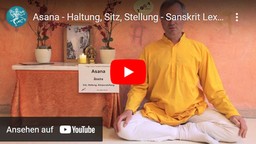
 |
 |
Swami Saradananda on Asana
Asanas are the most popular and widely used Yoga Practices in the West. If a friend says to you «I'm attending a yoga class», you'd probably think she's doing physical exercises. Nevertheless, Asanas are different in many ways from most forms of physical activity. Their purpose is not to build muscle by mechanical movement; rather, your full attention is required. Yoga sees your body as a vehicle for your soul on its journey to perfection.
When practiced regularly, the Asanas promote your mental abilities, expand your consciousness, and spark your spiritual desire. Good health and physical fitness are a welcome by-product, but not the ultimate goal of Asana practice. The true aim of Asanas, like all other Yoga Practices too, is inner peace.
Asanas focus on slow, gentle and non-violent movements. Basically, a yogi strives not to harm a living being, including himself, in thoughts, words or deeds. Nonviolence includes being unrivaled, being with others and not being too strict with your own judgment about yourself. It is best if you never force your body into any position.
To master the Asanas, work both steadily and slowly. Quick movements often result in an accumulation of lactic acid in your muscles, leaving a feeling of fatigue and stiffness. Lactic acid can be neutralized by increasing the oxygen levels in your cells. This is one of the reasons that Asanas are accompanied by a markedly deep breathing. Each Asana is a position that exerts pressure on a specific point (or points) much like acupuncture or Shiatsu. While you hold the position, you breathe deeply. Instead of thinking about something else, you actually focus your attention on the tension and consciously «breathe» out of your body. By using your mind, you develop the ability to control your body.
Instead of consuming your energy, as is the case with most types of physical activity, you feel energized and strengthened after the Asanas. This is because they allow you to relieve tension that has accumulated in your muscles. Through practice, the Asanas help you release energy blockages. The declining energy becomes usable; it starts to circulate throughout your body and you feel invigorated!
Asanas have an impact on your body in every way, not just on muscles and joints. These massage your internal organs, stimulate the circulation and increase your breathing. These make your mind steady, focused and ready for meditation.
A better translation for the word «Asana» would be pose, position, or seat. The term implies much more than physical activity. Its roots are linked to the idea of being fully present in the moment and being stuck firm in the body.
A few General Guidelines for Asana Practice
➳Begin your practice in a Back Relaxation in Savasana (Death Position) for at least five minutes.
➳After relaxation, warm up your muscles and make them fit with six rounds Sun Salutation.
➳Before doing any Asana, make sure that you understand the theory of how to do it.
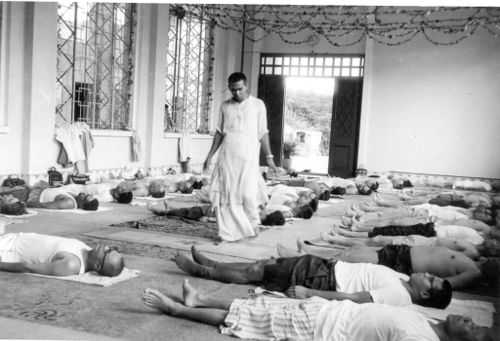 Swami Vishnudevananda teaches Hatha Yoga at the Sivananda Ashram in Rishikesh
Swami Vishnudevananda teaches Hatha Yoga at the Sivananda Ashram in Rishikesh
➳Do not hold back your energies and do not try to save them. Be generous with yourself. Remember, the more energy you put into your exercise, the more you will get back.
➳Work from your own point of view; work with what is available to you. Your experience and previous training make you unique. Do not try to compare yourself with others. Yoga is not competitive.
➳Come slowly and leisurely to any position. Do not jump into the postures and try not to force yourself into them. Do not move carelessly; try to consciously connect with every movement.
➳At the beginning, practice each Asana a little bit shorter; gradually increase the time you keep them.
➳Allow your stretch to easily exceed your reach, but pause before you feel pain.
➳Take a deep breath while keeping some pose.
➳Use your breath to relax and try to relax in EACH posture.
➳While you stay in position, mentally check your body. If you find any tension in your body, try consciously «exhaling» it.
➳Finish your session with a relaxation that allows your energies to flow freely through the entire body.
➳It is always best to learn the Asanas from a qualified yoga teacher.
➳Enjoy your training!
Positions to Exercises of the Body
Asanas can be divided into different groups. One way is the following:
➳Standing Asanas: Tadasana, Trikonasana, Garudasana, etc.
➳Sitting Asanas: Padmasana, Lolasana, Dandasana, Baddha Konasana, etc.
➳Forward Bends: Paschimottasana, Janushirshasana, etc.
➳Twist Postures: Bharadvajasana, Marichyasana, usw.
➳Reversal Postures (performed head-down and leg-up): Shirshasana, Vrikshasana, Sarvangasana, etc.
➳Backbends: Ushtrasana, Urdhva Dhanurasana, … .
➳Asanas in Lying: Uttanapadasana oder Pavanamuktasana, … .
Who can do Asanas?
Basically, you can practice Asanas from the age of ten to twelve years, but there are also extra yoga for children. Twenty to thirty year olds can perform all Asanas well. A two-month practice makes the stiff tendons, muscles and bones very supple. Even old people can do all Asanas. These can do without Shirshasana if you are physically unable to do so. But there are people of advanced age who also practice Shirshasana.
Tools such as blankets, ropes, chairs and wooden blocks make it easier and longer to practice the Asanas. This makes it easier for older, inexperienced and less mobile people to access the yoga postures. The Asanas can be taken more easily and practiced with greater certainty. Very valuable is the use of aids for people who want to take a certain attitude, but because of balance problems, fears or other disabilities this cannot so easily.
Videos about Asana
Yoga for Beginners
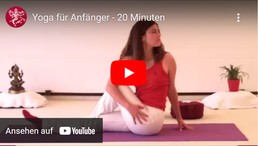
 |
 |
Yoga Class Intermediate — Yoga Vidya Basic Series
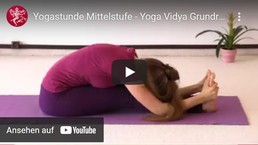
 |
 |
Asanas, the Body Positions — Teaching with Sukadev

 |
 |
Asana Dance Performance
